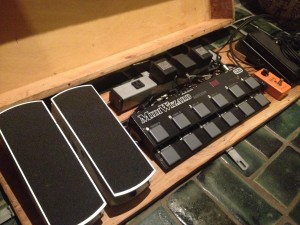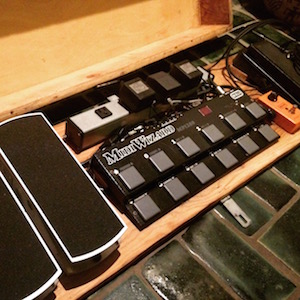
Becoming a phoenix of sound. That’s my new mission as of January 1st 2015. I didn’t consciously make a new year’s resolution about it, but I’m definitely on the path.
While in Las Vegas to play a gig in 2014, I was hanging with a good friend. He put on the TV while we were chilling and on came the show Austin City Limits from his DVR. It was the episode with Ed Sheeran playing some of his material as he does – solo acoustic with a looping setup. Instant inspiration struck me. Right then, right there. I pulled out my iPad to do a little research into what Ed uses to get his loops happening. It was a bust on the net with every site saying, oh he uses the RC-30 or some such little Roland pedal.
No way was it a little Roland pedal that I saw on the screen. It was something much bigger, much better. My buddy Brian, who’s house it was and who is also a musician, obliged me as I freeze framed the show at the few spots that had his pedal board on screen. Unfortunately there was no real clear shot of the name, nor of the make. [not until early January did I find a little corner of the web that gave a good detail of the box: The Chewie Monsta, Ed’s custom board.]
But boy did it hit me about how to approach the new singles I’m going to be dropping this year. Hit me in how to perform them live when I’m sans band. Thus began the process in my head.
Phoenix of Sound
I called another fellow tinkering musician late last year and asked if he’d be willing to embark on the mission with me. Mostly because he’s into making weird instruments and knew he’d appreciate it. So far its only been talk about where to get parts.
It dawned on me in early this year that I have an old midi pedal that I had for my amp rigs, just sitting in storage. A real tank build of a midi pedal (image above). Lots of tap dancing happened on this device early in my career. It still looks the same. It’s a super solid construction. In fact I don’t think any other midi pedal controller was as expansive or solidly built.
Leave to me to be the one person to find a flaw in it.
[pause for effect]
I know you’re thinking, what the hell is the flaw? Well, it has to do with the position of the expression pedals when you hit a patch change. Turns out that if an expression pedal was at a certain point in its range and I hit a sound change on the midi wizard. It would send the wrong expression pedal setting.
How did you figure that shit out Jody? (you ask).
Like any inquisitive musician with a computer, I hooked the midi wizard up to the computer and started stepping on the expression pedals and the midi wizard. What I found out was that if the pedal was between 0-60 in its range, it would get sent as 0. Above 60 and it was fine, the number would go out. Man what a pain in the ass that was on volume stuff. I did mention it to the people at Rolls who promptly told me, who cares – we don’t intend on fixing the issue. Ouch!!
So I had to make due with it, meaning that I had to rework a whole lot of carefully crafted amp settings to work around it. Not fun when a company couldn’t give a shit about a product bug. I don’t think they make the midi wizard any more and now there’s a midi buddy. But I wonder if they kept the bug in that product.
When I made the jump to using a laptop for recorded and live sound, I put my pedal board in storage with the rest of my amps. There they sat, unthought about. Neglected. Miserable. Not any more!
Rebuild
As of moments after this post goes live, I will start tearing apart the pedal board, assessing which parts to keep, and which to sell off. Then I will start tearing apart the midi wizard itself and thinking how I can take its guts and finding a new housing for it. See I’m thinking of doing something along the lines of the Chewie Monsta. Only a little more in depth.
I want to be able to create multiple loops. I want to be able to erase takes if needed. I want to be able to turn parts on and off. I want to have visual feedback from the board. I want awesome sound quality.
The first things come from the computer I’ll be tied to and its software. Right now I’m contemplating using MainStage along with Mobius. Mostly because MainStage can do almost all the things I need it to do with a full band setup. There are a couple of things I want it to do which will require a call to Apple. Thus why not use the same software for the acoustic setup, then its only a quick change of programs between which type of show I’m playing, full band or solo.
I could still use Ableton, I have that all set up for the full band thing. But that takes the fun out of learning new software right?
The pedal part doesn’t have all the feedback I need. Not the visual cue anyway. What I wish to do is put a laptop screen into the box on the floor. This will give me the visual feedback that I need from MainStage.
The next step is to start pulling things apart and finding a metal worker. Actually I already know one. I’m hoping he won’t charge me too much money to create a custom case to fit all these pieces into once I get it into working order.
Stay tuned, more pics and story about the journey will come.
